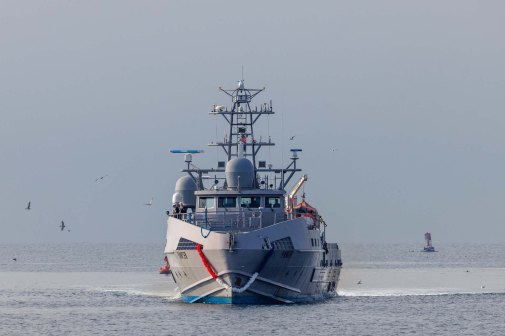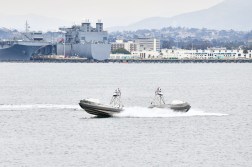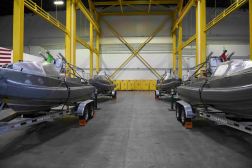Navy’s robotics-enabled mine countermeasures mission package achieves initial operational capability

The Navy’s new mine countermeasures mission package (MCM MP) — which includes robotic systems — has reached initial operational capability, according to service officials.
The pronouncement was made on May 1. The Navy also declared IOC for the AN/AQS-20 sonar mine detection system, which is a component of the mission package, the program executive office for unmanned and small combatants said in a release on Tuesday.
“An integrated suite of unmanned maritime systems and sensors, the MCM MP counteracts mines in the littorals while increasing the host vessel’s standoff distance from the threat area. Embarked with the MCM MP, [a littoral combat ship] or a vessel of opportunity can conduct the full spectrum of detect-to-engage operations (hunt, neutralize, and sweep) against mine threats using sensors and weapons deployed from the MCM Unmanned Surface Vehicle (USV), an MH-60S multi-mission helicopter, and associated support equipment,” it said.
According to the fiscal 2022 report from the Pentagon’s director of operational test and evaluation, the mine countermeasures mission package’s “baseline components” include the AN/ASQ-235 Airborne Laser Mine Detection System (ALMDS), Airborne Mine Neutralization System (AMNS), AN/AQS-20C and Unmanned Influence Sweep System (UISS).
Both the AN-AQS-20 sonar mine detection equipment and the UISS — which achieved initial operational capability last year — are towed by an unmanned surface vessel.
The mission package will also incorporate the Knifefish Block I unmanned undersea vehicle, AN/DVS-1 Coastal Battlefield Reconnaissance and Analysis Block II, and Barracuda Mine Neutralization System — pending continued system development, according to the DOT&E report.
“The declaration of the MCM MP and AQS-20 IOC is a significant accomplishment for … the future of mine countermeasures,” Capt. Godfrey Weekes, program manager of the LCS mission modules program office, said in a statement. “This milestone enables the Navy to field modern MCM systems to the fleet, replacing aging platforms and sensors. The new equipment utilizes cutting-edge unmanned and autonomous technologies and keeps our Sailors out of harm’s way.”
Initial operational test and evaluation of the mission package was conducted in August from the USS Cincinnati littoral combat ship near Southern California. The tech is expected to be fielded on Independence-class LCS platforms.
“This new capability includes advanced technologies in unmanned systems, allowing greater standoff from the LCS platform as the ‘mothership,’ as well as providing greater precision and capacity while keeping our personnel out of the minefield,” Brig. Gen. Marcus Annibale, director of expeditionary warfare and resource sponsor for mine warfare, said in a statement.
The fiscal 2022 DOT&E report noted that the Navy evaluated the capability of the mission package to execute mine clearance missions against “threat-representative mine surrogates,” and “testing was sufficient to demonstrate coordinated command and control of the baseline capabilities.”
The Navy also tested the MCM unmanned surface vessel with the mine-hunt payload in conjunction with the test and evaluation of the mission package, it noted.
Sam Taylor, mine warfare senior leader in program executive office for unmanned and small combatants at Naval Sea Systems Command, said the service demonstrated “the entire MCM kill chain” during the testing.
NAVSEA is currently working with the fleet on the introduction of these technologies, he noted during remarks at the ASNE Combat Systems Symposium in January.
“In addition, we continue to demonstrate our ability to employ the package — both USVs as well as the other systems that are part of the mission package — on other vessels of opportunity beyond the littoral combat ship,” Taylor said.
“As we field the MCM mission package, we will continue to work on enhancing technologies [such as] automated target recognition, which includes artificial intelligence and machine learning; autonomy, which is a key component to the operations of the unmanned systems away from ship; [and] situational awareness, which feeds into our autonomy, sensors and systems,” he said.
The sea service is planning to make improvements and upgrades as it pursues next-generation capabilities, he noted.
“Bottom line is this: What is good for unmanned systems is good for mine warfare at this point,” Taylor said.






